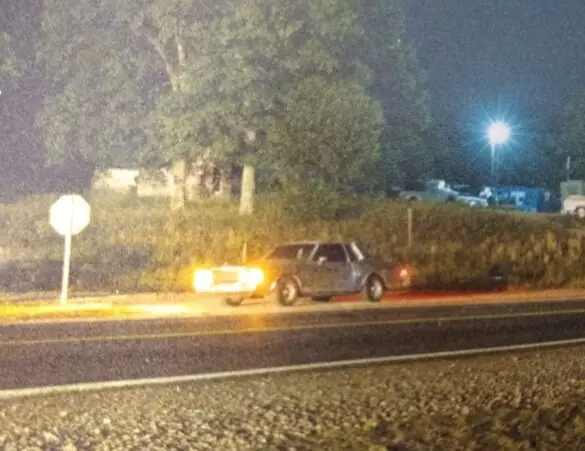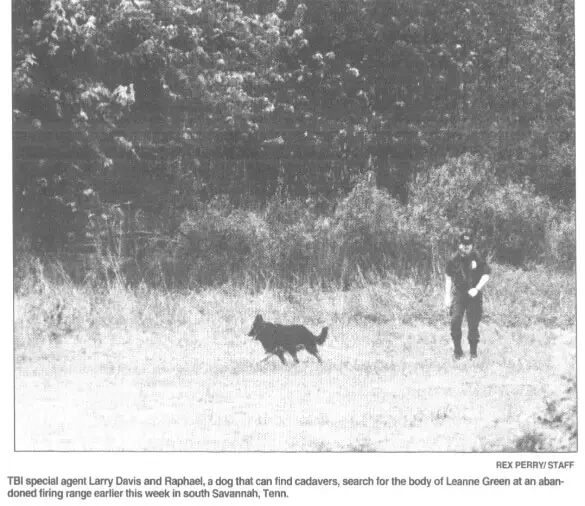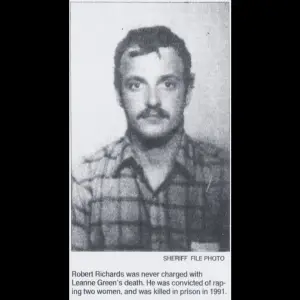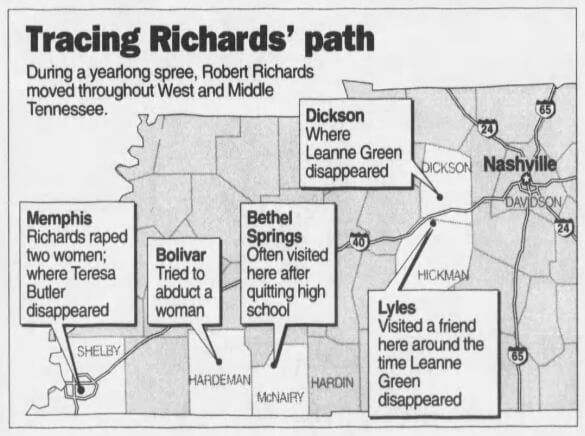Martha Leanne Green was born to George and Marjorie “Margie” Green on February 24, 1970. She has a twin brother, George Lawson Green, who also goes by his middle name, and two older sisters, Lisa and Laurie.
Leanne’s father was a U.S. Army veteran and Purple Heart recipient who worked first as an accountant and then later at a local post office. Her mother, Margie Green, was employed as an accounting clerk for the state of Tennessee. The Green family resided in White Bluff, Tennessee, about 30 miles west of Nashville.
Leanne, 17, attended Dickson County High School as a junior and held a part-time hostess job at the Dickson Holiday Inn at 2420 TN-46 ( I-40 at exit 172), roughly 10 miles southwest of her home. She and her family also went to White Bluff Church of Christ.
Beautiful and on the cusp of adulthood, Leanne was looking forward to her upcoming high school prom in April 1987. She planned to attend the dance with her date, Blain Snyder, 19, who described her as “real quiet” and said she had no enemies. Leanne was a “real nice person” and “so different from everyone else I had ever dated,” Snyder said in 1987.
Leanne laid her prom dress on her bed before heading to her evening work shift on April 15, 1987. Little did she know, she would never wear that dress, and it would remain on her bed for a long time.
The Disappearance of Martha Leanne Green
On April 15, 1987, Lawson Green borrowed their cousin’s 1979 silver Monte Carlo with tinted windows to pick up Leanne at work. Around 9 p.m., as they headed north on Highway 46 toward home, the car ran out of gas near Fabric Road in Dickson, in front of The Barn (now permanently closed, according to Google) and railroad tracks.

On their way home from church, a family of four saw the vehicle with its raised trunk door and flashing lights and pulled over to assist. They took Lawson to a Shell gas station to fill a gas can. The Charley Project states that Leanne told Lawson she was scared but chose to stay in the vehicle. Another source stated she wanted to listen to the radio.
When Lawson and the family returned to the car about 10 minutes later, Leanne was gone. Her purse and the car keys were still inside the vehicle.
Search and Investigation
The first responding officer was Jeff Bledsoe, then 19 and a rookie deputy for the Dickson County Sheriff’s Department. He was elected the Dickson County Sheriff years later.
“I could see no signs of a struggle and her belongings left in the car had me thinking she was expecting to return back to the car,” he told The Tennessean in February 2022.
Authorities launched a massive search involving dozens of volunteers but never found Leanne. During the search, they discovered a white sweatshirt, a pair of blue jeans, and socks. Leanne last wore a white long-sleeve sweatshirt, faded blue jeans, Reebok high-top tennis shoes, and earrings. A friend of hers claimed the clothing did not belong to Leanne, and police said they were men’s clothing.
What are the chances! Do you believe that?

Margie Green said Leanne “never spent the night or ever gone anywhere for any length of time without me knowing where she was – even in broad daylight.”
Authorities set up a roadblock between 8:45 p.m. and 10 p.m. along Highway 46 a week after Leanne disappeared, stopping vehicles and asking motorists for information. They were also “interviewing and re-interviewing” potential witnesses but refused to further comment to the local media.
Two witnesses claimed they saw Leanne at roadside stops along interstates between Virginia and Ohio. In both cases, the young girl appeared drugged or tired and accompanied by a man. The witnesses said the girl appeared as if she did not want to be with the man. (Hobbs 1989)
Police could not confirm the girl was Leanne. Overall, investigators had few leads and no evidence of her fate. It was not long before they had their first suspect, however.
Robert Richards

In the fall of 1987, Robert Richards, then 22, was serving time at Lake County Regional Correctional Facility, now the Northwest Correctional Complex.
In a May 1995 interview with The Tennessean, W.J. (Buck) Wood, a former Shelby County detective, declared: “Richards looked me square in the eye and said, ‘I swear on my mother’s life that I killed Leanne Green.'” (Thomas 1995a., p. 1A)
In August 1987, Richards was charged with sexually assaulting two Memphis women and attempting to abduct another woman after pulling her car over with his police blue light in Hardeman County. One of the women he assaulted was a St. Francis Hospital employee. (Thomas 1995c., p. 17A)
Richards agreed to undergo hypnosis in the fall of 1987. While hypnotized, he surprisingly gave two pieces of crucial information in Leanne’s case only the killer would know: 1) Leanne was on her menstrual period, and 2) he described a distinctive piece of jewelry she wore. (Thomas 1995a., p. 17A)
That confession started a four-year cat-and-mouse game with investigators in which Richards would confess, recant, and confess multiple times again.
“On several occasions, detectives took him from his cell on the promise of leading them to Leanne’s body, only to lead them on dead-end searches.” (Thomas 1995c. p. 17A)
One investigator asked Richards why he refused to say where he buried Leanne.
“I just can’t give her up,” he said.
After his arrest, three people came forward with information about Richards.
Angie Moss, Richards’ girlfriend in 1987
Moss lived in Hickman County and began dating Richards in May 1987. How they met is unclear, but she told authorities an interesting story.
As reported by The Tennessean:
One day in June or July that year, he convinced her to move to Memphis. As they drove through Dickson along Highway 46 toward the entrance ramp, Richards began telling Moss “about this girl he had killed … He told me that she was 16 and that she had brown hair and brown eyes…
“He was telling me about one of his greatest sexual experiences was when he kills this girl … They were having sex when he killed her … Stabbed her …”
Authorities asked Moss how many times Richards stabbed the girl, she said, “Seven, I think.” Then they asked why he killed the girl. “It turned him on, I guess,” Moss replied.
Donnie Dean
Dean was an inmate at Lake County prison and became friends with Richards, who allegedly confessed to Dean that he sexually assaulted and killed Leanne.
“He said he stabbed her several times because she kept screaming,” Dean said.
Eric Price
Leanne’s parents visited Richards at Lake County prison in 1989, and begged him to tell them what he had done to Leanne and where he buried her. To their frustration, he denied killing their daughter.
Price was cellmates with Richards.
“Robert said he was relieved because he thought he had convinced them that he hadn’t killed her,” Price said of Richards’ visitation with the Greens.
“He said he thought that would put them at peace. Then, he smiled a little and admitted to me that he really did kill Leanne Green.”
Two years later, on July 32, 1991, “Richards, then 26, convinced Price that he was a CIA agent marked for a cloak-and-dagger death. Richards told Price that the CIA would sneak into their cell and kill both of them – if Price didn’t kill Richards first.” (Thomas)
“He made it sound so real, that I believed him,” Price said.
A few hours later, Price strangled Richards with an extension cord in their cell. (Some reports say Price stabbed him) Richards remains the primary suspect in Leanne’s disappearance.
More About Robert Richards
Robert McKinley Richards was born to Jerry and Jewel Richards on July 11, 1965, and grew up at 2471 Ayrshire Cove, Memphis.
Jewel Reed was an overprotective mother, whereas Jerry Reed was an “extremely rigid individual with considerable suspiciousness and religiosity and apparently was rather abusive when Robert was a child,” wrote Memphis clinical psychologist John Hutson in his 1988 psychological report on Richards.
Richards claimed to police in 1988 that he had witnessed the abduction and rape of a woman when he was around eight years old. He said the assailant had parked his vehicle down the street, waited for the woman to drive by, then “pulled her over like he was the police,” according to his police statement.
Richards dropped out of Ridgeway High School and began heavily drinking alcohol in his late teens and continued through his early 20s.
In November 1986, Richards began training to join the Shelby County Sheriff’s Emergency Services Team, a group of volunteers who aided the sheriff’s department in various situations, such as extensive land searches. Shelby County Chief Deputy Ray Mills kicked him out of the program on May 14, 1987.
Richard’s girlfriend at the time was Linda Porter, then 31. She later told Shelby County officials that Richards told her he was a lieutenant for the sheriff’s department.
“He was dressed in spruce green pants, tan shirt, tie, the boots, fully equipped utility belt … a hat with the sheriff’s department patch on it and a windbreaker with the Sheriff’s Department Fugitive Squad logo on it,” Porter said.
Porter was with Richards one night when he pulled two teenage boys over using his blue light in his vehicle. She became suspicious and broke up with him in July 1987.
Richards told multiple people he worked in law enforcement, even donning Shelby County deputy uniforms. It is unclear how he obtained the uniforms, but news reports said he had three.
It’s possible that Richards saw Leanne sitting alone in the disabled Monte Carlo. While impersonating a police officer, he lured her out of the car. Richards likely told her that he would take her to the police station. Instead, he took her elsewhere and sexually assaulted and killed her.
It’s worth noting that Richards had not killed anyone up to his 1987 arrest; he left his victims alive. So, Leanne might have been his first murder victim, or he did not kill her.

Other Disappearances
One day after Leanne’s abduction, four-year-old Marlena Danyele Childress was kidnapped while playing in the front yard of her family’s home in Union City, about 115 miles west of Dickson and north of Memphis.
Cathy Gantt, 22, was abducted from Jackson, TN, between Dickson and Memphis on I-40, on April 18, 1987. Nashville police later arrested Larry Mullikin, 36, an ex-convict, after two witnesses identified him as the man who took Gantt. Mullikin had a criminal record that included rape.
Dickson authorities initially considered a possible link between all three abductions. However, Gantt was later found safe and testified against Mullikin in court. That case appeared to be an isolated incident and Mullikin was released from prison in 2006. Gantt passed away at age 48 in 2013. Unfortunately, Marlena remains missing today, and police never linked her disappearance to Leanne’s.

On November 18, 1986, Teresa Ann Butler, 26, disappeared under similar circumstances to Leanne’s abduction. She had just finished her shift as a student nurse at St. Francis Hospital in Memphis and was on her way home when she vanished. Her car was in the middle of Monterey Road, a mile from her home, with the engine running and the lights, radio, and windshield wipers on.
Butler worked at the same hospital where one of Richards’ Memphis assault victim was also employed. St. Francis Hospital is only about a mile from the Richards family home.
Richards confessed to killing Butler, and her sister said in 1995 that she believed it as well. However, Shelby County authorities discounted Richards “when several supposed burial sites did not contain a body.” (Buser 1992)
Butler’s sister, Pam Dangar, who then lived in Atlanta, claimed Shelby County sheriff’s deputies told her that her sister had “left on her own, that she’s probably somewhere in California, outrageous stuff like that,” Dangar said. (Thomas 1995b.)
Dangar further stated, “I’ve never been able to think or believe Teresa would have stopped in the middle of the road unless she thought she had to for some good reason. I’m sure Teresa would have stopped if she thought it was a police officer – just as sure as I am that Richards took Teresa and killed her.”
It’s unclear what happened in the Butler investigation as there is little information available. Surprisingly, Butler is not listed on The Charley Project or The Doe Network, but she is on NamUs.
Aftermath
Despite Richards’ numerous confessions to killing Leanne, no evidence pointed to him as her killer, and police never recovered her body.
Two years after Leanne disappeared, a trucker named Henry Harris, Jr. attempted to kill himself in Biloxi, Mississippi, in March 1989. Harris had driven his truck into the Biloxi Veterans Hospital parking lot and then shot himself in the chest with a .22-caliber gun but survived. (Hobbs)
Harriss had left a note in a briefcase. He wrote, in part, that he had “wanted somebody, a girl, he could call his own. ” He also had several fliers about Leanne’s disappearance and a picture of a young girl. Biloxi authorities thought she might have been Leanne and forwarded it to Tennessee authorities. However, Tennessee Bureau of Investigation agent Mike Breedlove said it was “definitely not Leanne Green.” The girl was a relative of Harris’s.
Agents planned to travel to Biloxi to interview Harris if they could place him in Dickson on the night Leanne vanished, but whether they did is unclear. However, Harris is not mentioned in news articles after 1989.
I think investigators had tunnel vision in Leanne’s case. They had their minds set that Richards abducted and killed her and seemed unwilling to lean away from that. Even after his cat-and-mouse game and failing to lead them to her body. To clarify, I am not saying Harris did not kill her, but I believe authorities should have been more open to other suspects, and it does not appear they were.
Leanne’s disappearance is a cold case; however, investigators still regularly review the case.
Leanne’s mother died of cancer at age 57 in 1997, and her father died at 91 in January 2023. He had remarried after her death. Leanne’s twin brother, Lawson Green, and her sisters reside in Tennessee.
Sources
Buser, Lawrence. “Butler Asks Court to Declare Missing Wife, Teresa, Dead.” The Commercial Appeal (Memphis, TN). July 22, 1992.
Butler, Lacrisha. 1987a. “Search For Teen Called Off.” The Tennessean (Nashville, TN). April 19.
—1987b. “No Link Yet in 3 Missing Female Cases.” The Tennessean. April 22.
Gadd, Chris. “Still No Closure in Missing Teen’s Case.” The Tennessean. February 6, 2022.
Good, Meaghan. “Martha Leanne Green.” The Charley Project. https://https://charleyproject.org/case/martha-leanne-green Accessed January 14, 2024.
Hobbs, Bill. “Truck Driver May Be Lead To Leanne.” The Leaf-Chronicle (Clarksville, TN). March 31, 1989.
Luxen, Emily. “36 Years After Dickson Co. Teen Disappeared, Investigators Still Dig For Answers.” News Channel 5 Nashville. April 15, 2023. https://www.newschannel5.com/news/36-years-after-dickson-co-teen-disappeared-investigators-keep-digging-for-answers Accessed January 14, 2024.
Obituary. “George Washington Green, Jr.” Dickson County Source. January 18, 2023. https://dicksoncountysource.com/obituary-george-washington-green-jr/ Accessed January 14, 2024.
Obituary. “Marjorie Marie Ladd Green.” The Tennessean. February 3, 1997.
“Roadblock Information Studied in Hunt For Girl.” The Tennessean. April 24, 1987.
“Suicide Attempt Gives Dickson Officials Lead in Missing Teen Case.” March 31, 1989. The Tennessean.
Thomas, Susan. 1995a. “‘I Killed Leanne Green.'” The Tennessean. May 7.
—1995b. “Memphis Woman’s Disappearance Parallels Leanne’s.” May 7.
—1995c. “Richards Disguised Problems With Lies, Uniforms.” May 7.
Yarbrough, Leigh. “Crowded Home Still Empty Without Missing Teenager.” The Tennessean. April 18, 1987.
Image of Leanne at the top of the post: Dickson County Sheriff’s Office, Facebook.




